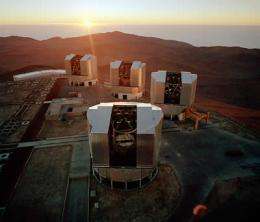(PhysOrg.com) -- Researchers working as part of the European Southern Observatory (ESO) at the Cerra Paranal Mountain Observatory in the Atacama Desert in Chile, have succeeded in virtually connecting all four main Unit Telescopes (UTs) at the site, completing a project ten years in the making. Connecting the telescopes together virtually allows for the creation of a single virtual mirror that allows researchers to capture images from space as if all of the telescopes were in fact one giant telescope with a mirror 130m in diameter. Combined, the telescopes are known as the Very Large Telescope (VLT).
Connecting the telescopes together was no easy feat, in fact the team had tried last March and failed. To make it all work the facility was built with interconnecting underground tunnels. In those tunnels, an interferometer (and a device with an optical microchip called the Pionier) is used in conjunction with many smaller mirrors to direct light beams from each telescope, adjusting for the slight differences in arrival time due to the different positions of the telescopes on the surface. Connecting the telescopes together improves on spatial resolution and zoom capabilities by a factor of 20.
The team had succeeded in connecting various parts of the VLT before, but this was the first time they managed to get all four telescopes connected at once. The VLT is the largest virtual optical telescope in the world and astronomers the world over have reason to be excited about the accomplishments of the ESO as access to the VLT will be offered to both those that work at the observatory and visiting researchers.
The ESO is a research group made up of scientists from fourteen European countries and Brazil. It’s been in existence since 1962 and is funded by various state governmental agencies. Its mission is to advance the science of astronomy by providing researchers with state of the art facilities. To that end, it has built some of the biggest and most advanced telescopes in the world.
The ESO team believes the new virtual telescope will allow researchers to discern far off objects in the sky with much more detail, providing more insight into such phenomenon as how various entities come together to form new solar systems. The team has also set up a site where those that wish to can take a virtual tour of the facility.
© 2011 PhysOrg.com





















